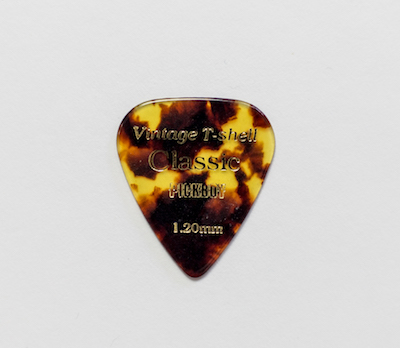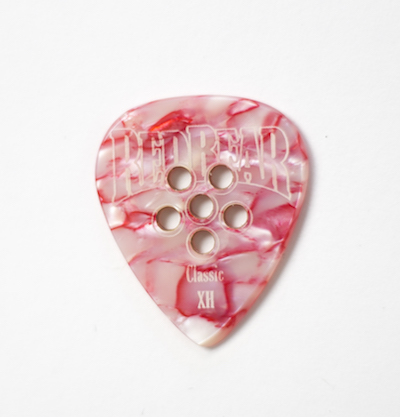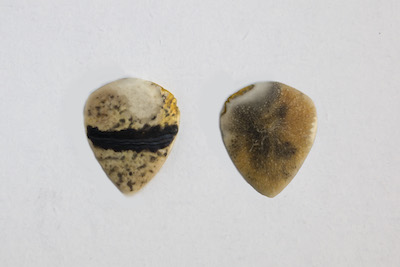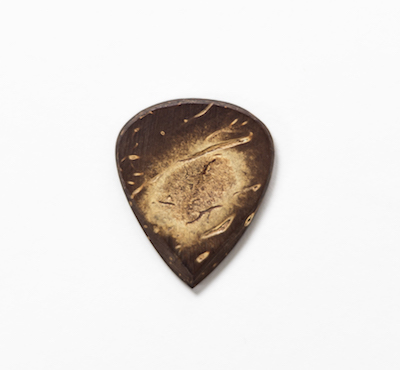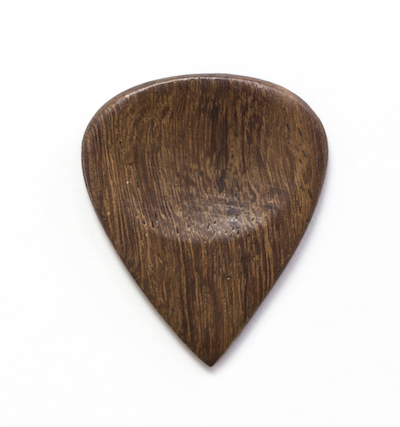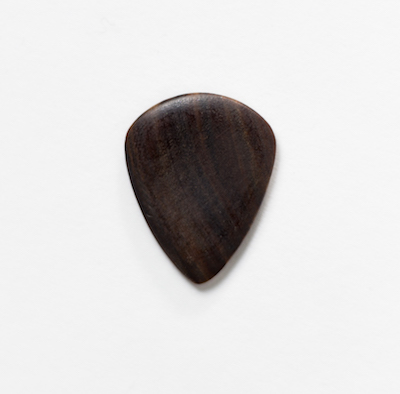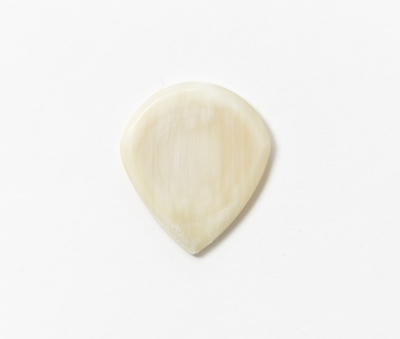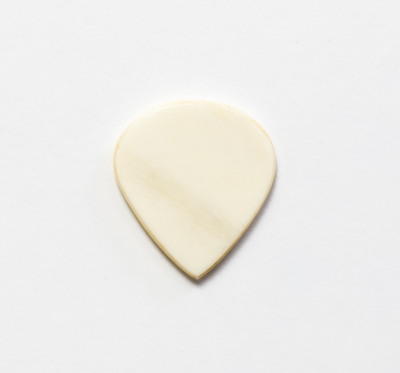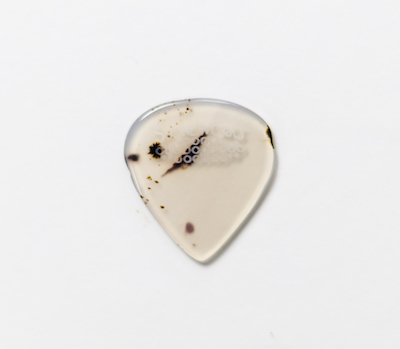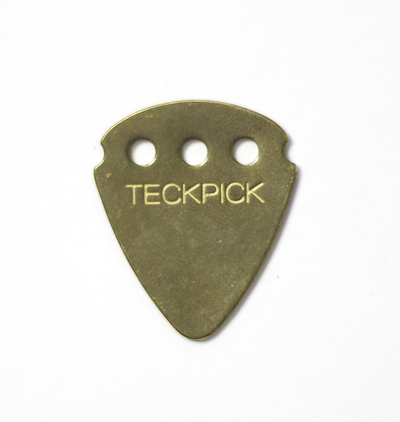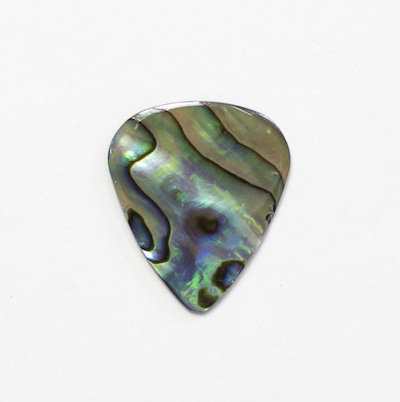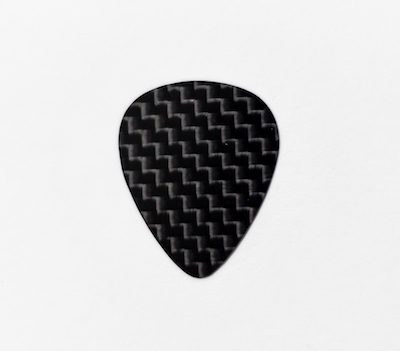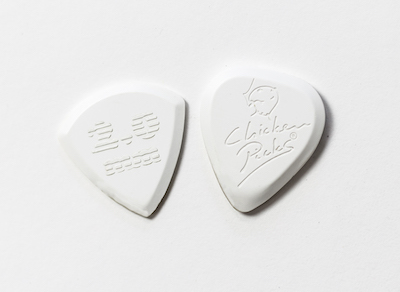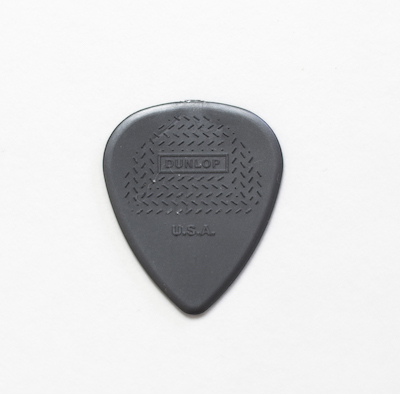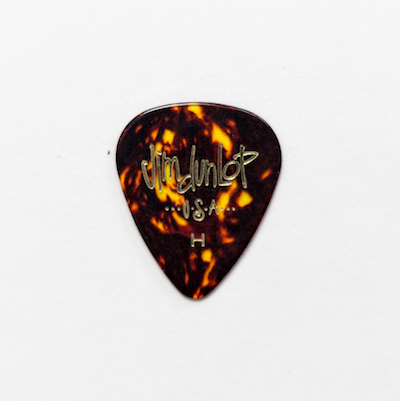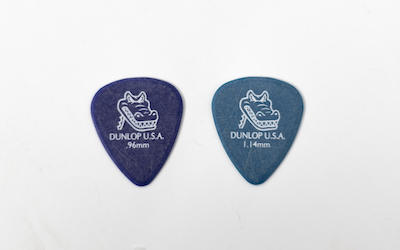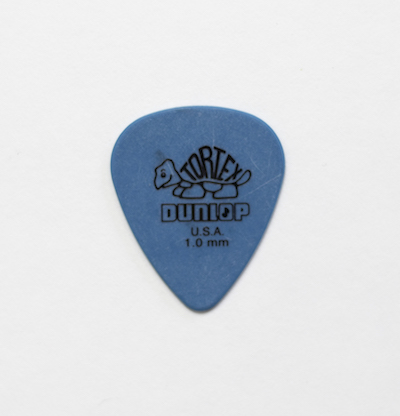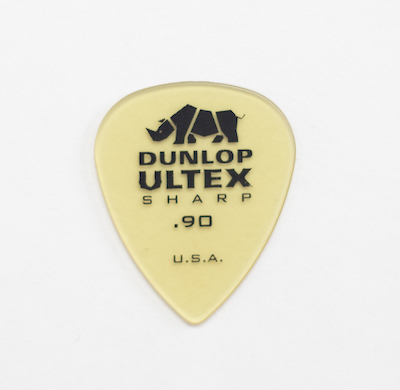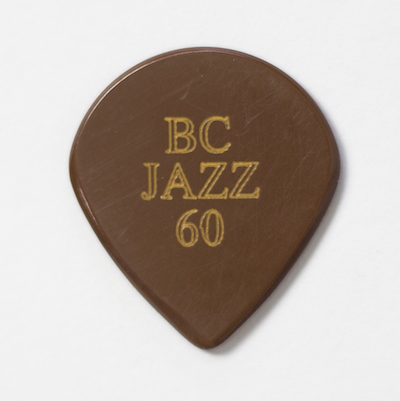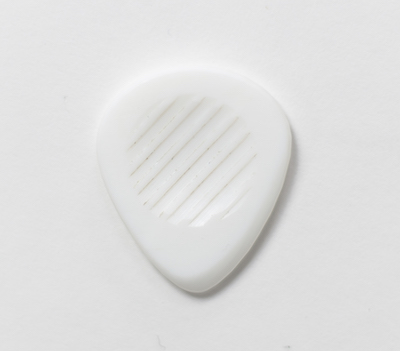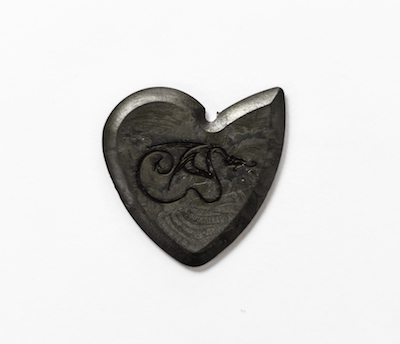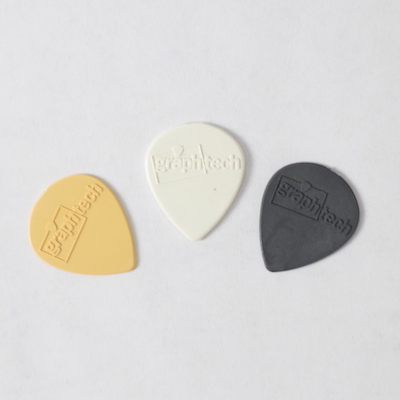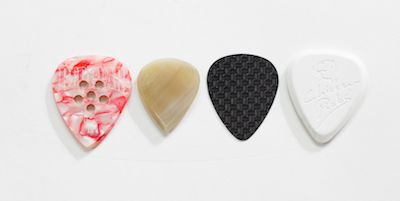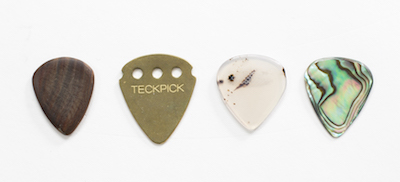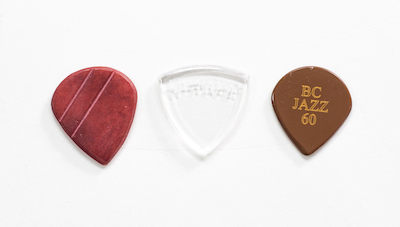Complete Guide to Guitar Picks

Updated September 18, 2017.
Glossary
When it comes to picksA small piece of material used to play the guitar strings. Also called a flatpick or a plectrum., everybody has their own preference. Some players use a small, hard pick and others use a thin, floppy pick. And quit your snickering, because we’re not done yet: others use a pick combined with their fingers, and still others use no pick at all.
When Should You Use a Pick?
Most electric guitar players use a pick. For acoustic guitar, picks are often used for strumming chord progressions. Picks are also very good for playing single-note lines as in lead guitar, melodic playing, and improvising.
Choosing a Guitar Pick
There are a few key characteristics of a guitar pick.
Pick Material
- Density and flexibility which affects the playability and the way the strings respond to the pick.
- Fracture resistance which affects mostly what gauges are available for the material.
- Hardness, which affects the scratch-resistance of the material as well as its tendency to wear over time.
- Smoothness. The smoothest picks glide off of the strings, whereas the roughest ones don’t—and sometimes make an unpleasant noise as they meet the string.
- “Feel”, a subjective quality making the pick pleasant to grip.
Pick shape and size
- Shape which can affect how it wears, and how easy it is to grip.
- Edge sharpness which can affect how easily the string “glides” off of the surface of the pick.
- Edge bevel, the shape of the actual contour of the picking edge, which can affect the string’s resistance. Note that plucking with an upstroke will use a different part of the pick’s bevelled contour than with a downstroke.
- Thickness (gauge), one of the most important factors affecting the pick’s overall playability and tone—and often a matter of both player preference and the requirements of whatever material is used.
A few gross generalizations
- Guitar learners should start with a medium-gauge, grippable pick, with a rounded tip.
- Picks made of more flexible materials and thinner gauges tend to be better at strumming than picking lead lines.
- Picks made of more rigid materials and thicker gauges tend to be better at lead lines than at strumming chords.
Picks Made from Natural Materials
A note about history
Historically, picks were often fashioned from hard but workable materials such as bone, horn, and shell.
By far the most famous material for pick-making, one with a cruel history and a lasting legacy, begins with the poaching of the hawksbill sea turtle for its carapace, which was often fashioned into hair combs, decorative items, and, yes, musical accessories.
Tortoiseshell Picks
Strengths: flexible low friction famous tone
Weaknesses: illegal rare expensive
Tortoiseshell picks are often believed, perhaps erroneously, to be the “holy grail” of guitar picks. They are crafted from the shell of the hawksbill turtle, an endangered sea turtle. It is illegal to buy or sell this material in the US, although there are still some tortoise picks floating around.
Tortoiseshell picks are rare, expensive, fragile, and illegal! That’s a long list of reasons to avoid them.
Tortoiseshell is made of keratin, making it similar to the human fingernail, which is what makes it a good material for a pick. It is also conducive to heat, being cool to the touch but quickly reaching the temperature of the player’s fingers. The surface of the pick is smooth.
Most people probably could not distinguish a tortoiseshell pick from a standard plastic one when blindfolded. There are many substitutes for this material, and many picks bear names that give homage to the time when picks were made from tortoiseshell.
Hear a fake turtle pick.
Turtle Substitute (Red Bear Trading Company Picks)
Strengths: quality tortoise tone
Weaknesses: run thick hard to get
These picks are hand crafted at Red Bear Trading Company. They are in extremely short demand. The company is a one-man shop, essentially, and the picks are created by hand using a secret process.
What do we know about this process? It uses casein, a protein likely derived from dairy.
Pros: Red Bear picks are made of a unique keratin-based material, apparently similar to tortoise shell. They are attractive, high-quality, and made with great care. Users rave about these picks in the forums online.
Cons: These picks are difficult to come by. They are expensive, at almost $30 apiece. They also tend to run thicker than mass-manufactured picks. The lightest gauge is 0.9mm - 1.10mm. And due to the hand-crafting process, the gauges are not produced to a precise standard.
According to the Red Bear website, no animals are harmed in any way in producing these picks.
Hear a red bear pick.
Farmed Turtle Shell
Strengths: cool story, bro
Weaknesses: expensive rough picking
Turtle Shell picks are made from legal, farmed turtle shell. It would be reasonable to assume this is the closest thing available to the now-banned tortoiseshell pick. Same material, different species. However, the sea turtle is adapted to have a hydrodynamic shell that glides through the water (and across strings!), whereas the red eared slider turtle has a rough shell not well-suited for use as a pick.
If you'd like to try a turtle shell pick, there are many vendors on eBay offering them. They are around $30-40 apiece.
Hear a farmed turtle pick.
Tagua (Corozo) Picks
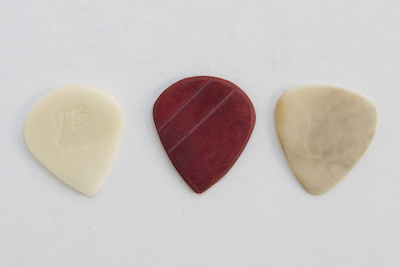
Tagua has intriguing properties for pick-making. Pictured: JB Picks (Left), Howling Monkey (Center), US Blues (Right)
Strengths: light-weight bright tone smooth release vegan
Weaknesses: inflexible run thick
Tagua, also called corozo or plant ivory, is harvested from a palm tree in South America. It is a hard white material that protects the seed of the tree.
Tagua is considered to be a substitute for ivory, which makes it an intriguing material for guitar picks.
For an awesome tagua pick, try Howling Monkey Picks. These come in red, green, blue and purple, and on average range from about 1.8mm to 2mm thick, according to the website. The company takes custom orders. Due to the fragility of the tagua material at thinner gauges, the picks do not come any thinner than 1.8mm. The pick used for this review had an excellent overall feel. It worked well for strumming and lead lines.
Another tagua picks are offered by JB Picks, as well as US Blues US Blues Tagua Pick (351)[?]Affiliate Link.
Hear the Howling Monkey Pick:
Coconut Shell Guitar Picks
Strengths: light-weight warm tone fast release vegan
Weaknesses: inflexible run thick
This material is surprisingly good. It is very hard, like Tagua, and has an attractive appearance. The pick is pleasant to hold, and has fairly good release from the strings, facilitating fast picking action.
The US Blues Coconut Pick (Jazz)[?]Affiliate Link and US Blues Coconut Pick (351)[?]Affiliate Link are very well-crafted, and a worthy addition to your pick collection.
This pick is a “must try”.
Hear the Howling Monkey Pick:
Sheesham Wood Picks
Strengths: bright tone
Weaknesses: wear quickly run thick
Wood is normally too soft to be useful for making guitar picks. Many players who have tried wooden picks complain that they wear down fast.
Since wood varies a great deal in hardness, the species of wood used matters alot. This Clayton pick is made of a very hard wood called sheesham: Clayton Wood Picks[?]Affiliate Link
Sheesham rates at 1780 on the Janka scale, used for comparing the hardness of woods. The higher the number, the harder the wood.
Hear the Sheesham Pick:
Surfpick (Lignum Vitae Wood)
Strengths: quiet tone
Weaknesses: run thick wood may wear
Lignum Vitae ranks at 4500 on the janka scale, more than 2.5x higher than the sheesham pick. This wood is among the very hardest woods on the planet, which is why it is great for making guitar picks.
The Surfpick is aesthetically pleasing, smooth to the touch, and available in various sizes and shapes. Highly collectible, this pick would make an awesome gift for a guitar player.
Hear a Lignum Vitae Wood pick:
Buffalo Horn Picks
Strengths: tortoise tone smooth release
Weaknesses: few choices run thick brittle
Natural buffalo horn looks and feels quite alot like tortoiseshell. In an alternate universe overrun by turtles, it may well have been the buffalo horn picks that got banned and the tortoiseshell picks being widely used as a substitute.
Buffalo horn picks are available from small shops and can be ordered online. They tend to run a little thick, though, except for the Flexi-Tones available via Timber Tones.
If you can get one of the right gauge and shape, buffalo horn picks have a wonderful tone and feel that is quite similar to real tortoiseshell. Unfortunately, the material does not always “wear down” as plastic does, but is prone to splintering almost like wood.
The best-quality buffalo horn picks are available on Amazon: US Blues Buffalo Horn Picks (Jazz)[?]Affiliate Link and US Blues Buffalo Horn Picks (351)[?]Affiliate Link.
Hear a buffalo horn pick:
Bone (and Ivory) Picks
Strengths: hard
Weaknesses: pick noise inflexible not smooth
There are some specialty shops offering bone picks, including US Blues and Clayton, both of whom offer exotic specialty picks on Amazon.
Bone is somewhat intriguing as it is also used to make nuts and saddles.
US Blues Buffalo Bone Picks[?]Affiliate Link were used for this review.
Bone picks are quite dense, and the surface has an unpleasant amount of friction. They do not “release” the guitar string very easily. This can result in an unpleasant string noise.
Hear a buffalo bone pick:
Stone Guitar Picks
Strengths: whopping tone
Weaknesses: inflexible not good for chords
Stone is a very dense material with unique tonal properties. The challenge with stone is that it is difficult to work with, especially for thin gauges. Most of the thinner picks on offer at Stoneworks Guitar Picks are 1.9mm or thicker.
And regardless of gauge, stone doesn’t have any flex in it at all.
Stone picks are not particularly useful for strumming chords, but they are good for single lines. They command a thumping tone from the guitar. However, the surface of the stone produces some friction and unpleasant “glassy” pick scratching noises. This means they’re probably a little better for electric guitars.
Hear a stone pick:
Metal Picks
Strengths: mega bright tone
Weaknesses inflexible rough on strings
Ever seen a sweater grow fuzz? Try playing with a pick made of metal, and your strings will do the same. The metal pick will damage the surface of the strings over time, causing a “fuzzy” effect. The Dunlop Teckpick is designed with a rounded edge to help minimize this effect.
Metal picks produce a bright, jangly tone.
This Dunlop Teckpick[?]Affiliate Link carries quite a bit of weight for its thin size, which adds some momentum to your playing speed. The added heft and metallic surface make it a pleasure to handle.
The drilled holes of the pick can be used to turn it into a necklace or attach it to a keychain for an always-available emergency pick. Its heft, attractive appearance, surprisingly good tone, and “cool factor” make it a “must try.”
Hear a brass Teckpick:
Abalone Picks
Strengths: stunning bright smooth
Weaknesses: inflexible
Abalone picks are perhaps the most beautiful pick of all. And they match the abalone inlay often used on acoustic guitars.
The tone of these picks is very bright. The picks themselves are surprisingly smooth and playable.
These are available through Timber Tones.
Hear an abalone pick. Note the brightness, bordering on shrill:
Picks Made from Synthetic Materials
Carbon Fiber Weave Picks
Strengths: thin flexible affordable
Weaknesses: not good for lead
A company called Pick Heaven offers the world’s thinnest pick at 200 micrometers, this pick is both flexible and sturdy, making it excellent for strumming chords—perhaps the best!
You may also want to try the pick they offer that is made out of ballistic weave fiber. Could it be the world’s first bullet proof pick?
Hear a carbon fiber pick. Its thin gauge lends itself to strumming:
Thermoplastic: Chicken Picks
Strengths: great bevel high quality
Weaknesses: only thick ones available
Made from a “high-quality and highly-durable thermosetting plastic”, Chicken Picks are one of the best synthetic picks available.
Of all of the synthetics, one of the nicest ones to grip in the hand is the Chicken Pick, which is pleasantly cool to the touch.
Chicken picks have no flex at all, perhaps owing to their thicker gauge.
These picks also have one of the best bevels of any pick. Although the picks are heavy, they have a very thorough bevel all around the edge of the pick. This allows the pick to pass through the strings with greater ease.
Hear a chicken pick. The heavy gauge really drives the strings:
Nylon Picks
Strengths: flexible cheap
Weaknesses: fragile (thin) not good for lead (thin)
Nylon picks have a slippery surface, and for this reason are often coated or textured so they are easier to grip. They can also be somewhat brittle. Thinner nylon picks will wear and shatter easily.
Nylon is wonderful for strumming chords because it is very flexible, but still stiff enough to pluck out individual notes or bass lines. Try some Dunlop Nylon .88mm Picks[?]Affiliate Link to experiment with this for yourself.
In thicker gauges, the slippery quality of nylon is useful, too, for playing fast lines.
Hear a nylon pick. Note the absence of pick noise:
Celluloid Picks
Strengths: vintage flexible cheap
Weaknesses: wears down
Celluloid has been a go-to pick material for decades, making it a favorite of vintage players. Celluloid is the original substitute for tortoiseshell, with many celluloid picks bearing a mottled pattern intended to mimic the look of tortoiseshell.
Celluloid tends to wear down a little faster than other materials, so over time the pick will have the a “worn-in” contour and shape. Some players find this desirable.
Try these in a Pick Variety Pack[?]Affiliate Link.
Hear a celluloid pick:
Delrin/Delrex/Acetal Picks
Strengths: no-slip grip flexible cheap
Weaknesses: unremarkable tone
One of the most ubiquitous materials in pick manufacturing is called Delrin. Many modern picks are made from this material. It has a matte, non-slippery finish. It is noted mostly for its durability and reliability. Its tone is not remarkable, though it has a slightly warm sound. It is very common and is sold under several trade names.
Try these in a Pick Variety Pack[?]Affiliate Link.
Hear a delrin pick:
Tortex Picks
Strengths: unique tone flexible cheap
Tortex is Dunlop’s primary material for guitar pick making. It wears more quickly than Ultem. Many players prefer the tone of Tortex. It is similiar to Delrin, but its exact composition is unknown.
Many (or most) Dunlop picks are made from Tortex. These are great general-purpose picks for beginners. Among inexpensive plastic picks, they rate well. Try these in a Pick Variety Pack[?]Affiliate Link.
Hear a tortex pick:
V-Picks (Acrylic)
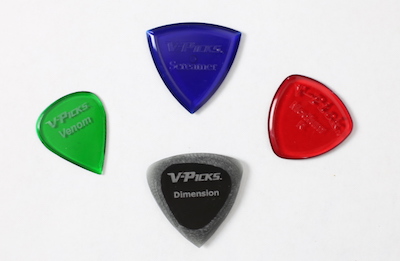
Acrylic picks are harder than other plastics. They last longer, wear more slowly, and are also a bit more slippery. These are some V-Picks.
Strengths: hard wear-resistant bright tone
Weaknesses: slippery
Acrylic has a translucent, glass-like appearance and a slippery feel. It wears slowly. This is good if you like a sharp tip, or if you otherwise don’t want your pick shape to change with wear.
Acrylic picks can feel slippery in hot weather, as the glossy surface collects perspiration. For this reason, it’s a good idea to try one with grip holes.
The tone of the pick is brighter than most picks.
Highly recommended are V-Picks, which are made out of a specially formulated acrylic that bonds to the fingers slightly, giving it a tacky feeling that makes it harder to drop.
Gravity Guitar Picks Are also worth mentioning. The picks are attractive, and they come in a plethora of shapes, sizes and options—allowing the keen player to find the ideal one for his or her own playing style.
Try out the V-Picks Variety Pack[?]Affiliate Link.
Hear an acrylic pick:
Dunlop Ultem/Ultex Picks
Strengths: tortex tone durable cheap
Ultem is a high-tech plastic that is extremely durable.
These picks are among the best synthetic picks available. They are cost effective, durable, wear smoothly, and produce a good tone.
If you'd like to try Ultex picks, try out the Ultex Sharp[?]Affiliate Link or the Ultex Jazz III[?]Affiliate Link.
A top mention goes to Dunlop Primetone 351 (1mm)[?]Affiliate Link. These are finished by hand to ensure quality. At $3-4 per pick, it’s worth the extra money to be confident you’re getting a quality product. Just be sure you know your ideal pick gauge and shape, first. Consider getting a Pick Variety Pack[?]Affiliate Link to figure out the gauge you want, and then order a Dunlop Primetone 351 (1mm)[?]Affiliate Link version of your ideal pick!
Hear an ultex pick:
Blue Chip Picks
Strengths: tone fast release many options
Weaknesses expensive
Blue Chip Picks are made from an advanced, heat-resistant superplastic.
These picks have good tone, are wear-resistant, and the material is extremely low-friction, which the manufacturer attributes to the fact that “it contains special lubricants”. (Have you ever heard that one before?) Blue Chip Picks had the smoothest picking action of any pick we tested.
Out of the synthetic picks, Blue Chip produced the best results in tone, feel and control. The picks were useful both for strumming chords and playing lead lines. In addition, they are manufactured to specific sizes and shapes, which makes it easier to choose the ideal pick for your own playing.
The difference is marginal so you’re unlikely to notice it in every single note you play, but after playing for awhile, will feel the difference. The more experience you have playing the guitar, the more you’ll be able to notice the difference.
Hear a blue chip pick:
Wegen Picks
Strengths: durable
Weaknesses inflexible
Wegen picks are made from an unknown material that is rumored to be some type of composite used for creating models and other molded materials.
Perhaps the most well-known Wegen pick is the Gypsy Jazz pick, at a whopping 3.5mm pick, and with a special textured grip. This pick is favored by many gypsy jazz guitar players.
Hear a Wegen pick:
Dragon’s Heart Picks
Strengths: multiple picking edges bright tone
Weaknesses single gauge only
Dragon’s Heart Guitar Picks are not made of anything secret; the website reveals that all picks are made of a plastic called polyamide-imide, with with different fills (graphite, glass fiber, carbon fiber). This is great news because we can educate ourselves, learn more about the materials used and choose our options.
Several Dragon's Heart Pick[?]Affiliate Links were tested for this review.
The material produced a clear, slightly bright tone. The pick was too thick for recommending to a beginner. But intermediate and advanced players may like to experiment with the pick as it has three picking edges. One is normal, another rounded, and another sharpened. This allows for creating multiple affects with one pick.
Hear a Dragon pick:
Tusq Picks
Strengths: multiple tones
Tusq is a material favored by guitar manufacturers for nuts and saddles. It’s “selling point” is that it has the tone and durability of ivory (which is now banned), but the workability of plastics.
Tusq picks are very interesting because they do have a resonant tone, which you can hear even as you drop them and they rattle off of the surface of a tabletop. There are three different types: white, which is brighter, black, which is darker and the orange color which has a medium tone. Interestingly enough, you can confirm this simply by dropping all three on a table in succession. You will hear the difference in tone as each pick falls flat.
Hear a Tusq pick:
Pick Thickness

Picks come in a variety of thicknesses. To generalize, thin are for strumming and thick are for plucking. Medium picks are versatile.
Every manufacturer of guitar picks adheres to their own standard for measuring gauges. Some picks are even sold with no particular gauge listed. Here is an attempt to make sense of pick gauges.
Pick thickness is one of the single most important factors in a pick. And it is the factor that makes it difficult to compare any two picks. To meaningfully compare two different pick materials, you must be sure that they are of the same gauge.
Picks manufactured from plastics are usually made by punching them out of a sheet or by melting the material and injecting it into a mold. These picks can easily be created in precise shapes, sizes and gauges. But picks fashioned from natural materials are not as workable. That’s why they’re so expensive, and there are not as many options.
If you really want to know the gauge of your favorite pick, you can use a pair of calipers to find out. This can be helpful in comparing lots of different types of picks.
Note that a large bevel can effectively reduce the gauge of the picking edge, which is why some thicker picks have a picking action of a lighter pick. It’s all in the bevel.
| Thickness (mm) | Rating | Notes |
| < .80 mm | Light | Picks lighter than .80mm tend to be thin and quite fragile. It is difficult to play lead lines with them, but they are wonderful for strumming chords. |
| .80 mm - 1.2 mm | Regular Gauge | Mass-manufacturers rate this gauge as “heavy” while premium pick manufacturers consider it to be “thin” |
| 1.2mm - 1.5 mm | Heavy Gauge | Picks at (or above) this level of thickness are often preferred by lead players. |
| 1.5mm - 2.00 mm | X-Heavy Gauge | |
| > 2.00 mm | Super-Heavy Gauge | Picks heavier than 2mm may be unplayable for some players, but it really depends on the bevel or picking edge. |
Pick Tip and Bevel
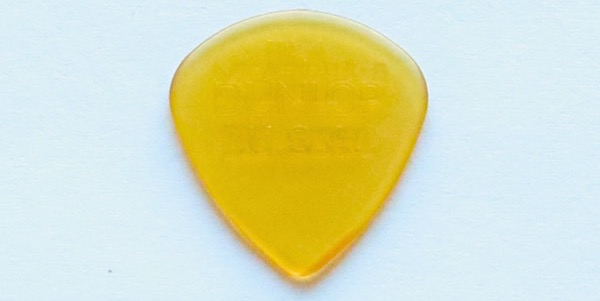
The right edge of this pick has been worn in from playing, which provides a faster release from the string. A bevelled pick imitates this natural wear, with the side being buffed by sandpaper.
The tip of the pick and its contour is perhaps more important than the pick’s shape. The pick tip may be pointed or more rounded, and in addition the playing edge may also be bevelled for higher speed. This is especially true of thicker picks.
A sharper pick might make lead lines easier to play (especially tremolo playing, as a sharper pick can pick more rapidly on the same string); however, many players prefer a rounded edge for strumming chords.
A tip that is too sharp is no good, either; picks are not intended to stab the strings, but to glide over them smoothly.
The bevel of the pick affects its attack on the string. A bevel reduces the degree to which the pick “grips” the string, creating a surface for the string to glide off of. For the sake of ease, many players will prefer a good bevel that allows the pick to glide off of the string. Thicker boutique guitar picks often offer a “speed bevel”. This compensates for the added grip of a thicker pick.
Pick Shapes and Styles
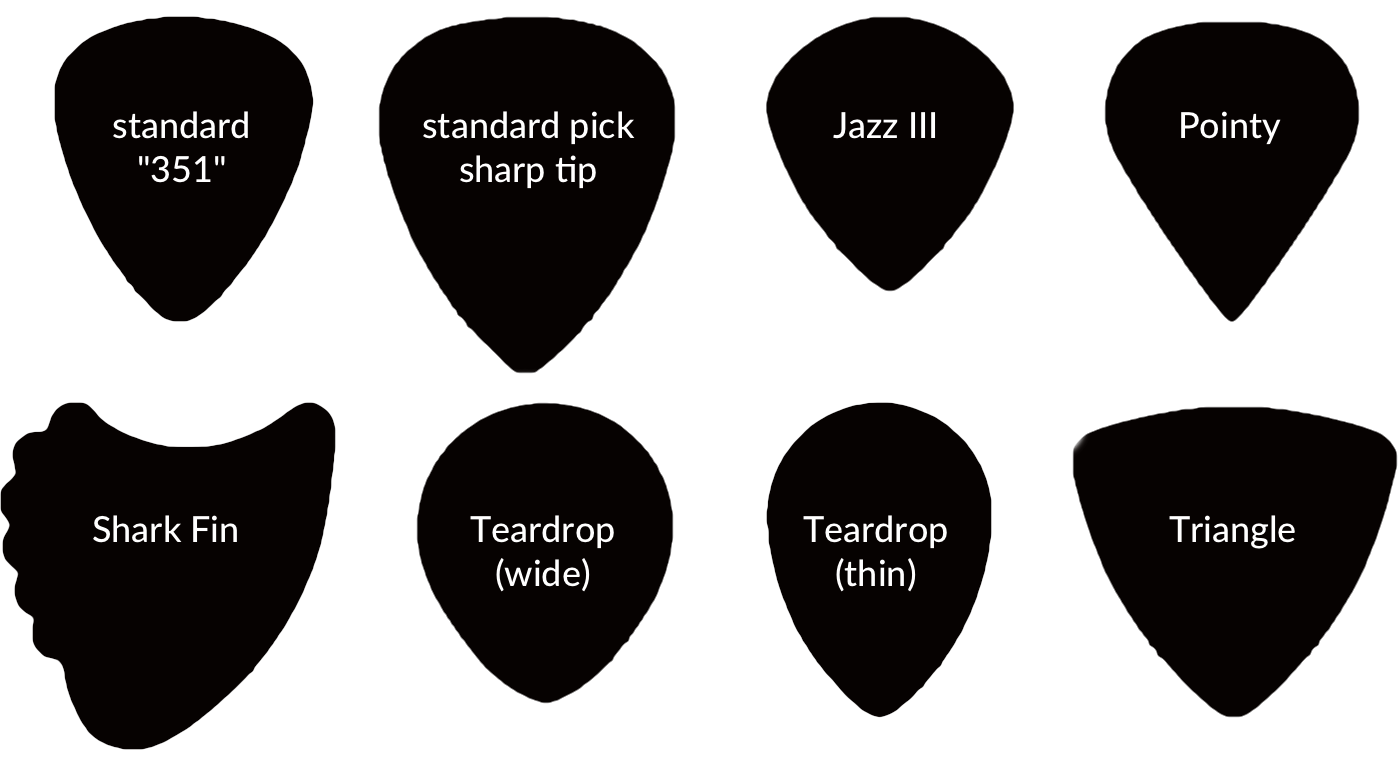
There are many pick shapes and styles. A few will be discussed here, along with the context they are most seen in.
A smaller pick shape is necessary for faster picking, as it grants greater economy of motion.
Don’t put too much stock in the guitar pick shape itself. The shape is mostly a function of the comfort in gripping it. The picking tip, however, is a bit more important. This includes its length, sharpness, firmness, surface friction, and bevel.
Standard Shape
This is the “standard” guitar pick that should be familiar to anybody. It is sometimes called “heart-shaped”, or 351 after the number manufacturers gave it. This is a good place to start. Picks of this shape come in multiple sizes, mostly a standard size and a smaller size. The tip is sometimes sharpened for more accuracy, or bevelled for smoother playing.
Standard Shape, Sharp Tip
This pick is slightly larger than the standard shape, with a pointed tip. Common examples include the Dunlop Tortex TIII and Dunlop Ultex Sharp. This is an interesting choice for beginners; it combines the ease of grip that the standard pick has with the greater control of the Jazz III.
Jazz III, aka Little Jazzer
A very popular pick that originated as a “jazz” pick but has since become popular among many players looking for increased speed and precision. It is similar to a standard pick, but smaller. The tip is usually sharpened. Picks of this shape normally come in slightly heavier gauges.
Picks of this size and shape are extremely popular among advanced players.
Pointy Pick
The sharpened tip is good for extra control, but it’s a little too awkward and sharp for most players. It’s also not terribly good for strumming.
Shark Fin Pick
A novelty pick. It can be played as normal with the rounded edge. The wavy “shark fin” edge can be used to create some interesting effects.
Teardrop (wide)
A variation of the standard pick, but with a rounder shape.
Teardrop (narrow)
If the teardrop is a variation on the standard pick, the narrow teardrop is a variation of the Jazz III. Its narrower form makes it a more challenging pick to wield, with tighter control.
Triangular Pick
This shape is sometimes preferred by bluegrass players, who play lots of chords and fast-picking lines. It can be a geometrically perfect triangle, or a triangular shape with rounded edges. It normally comes in a larger size only.
One advantage of the triangle is it has three identical edges. Which means that as one wears, you can simply switch to using another.
Other Shapes
Most other pick shapes are variations of or extensions of these three types.
Picks worn on the fingers
Finger & Thumb Picks
Finger picks can be worn on the fingers or the thumb; usually a player will use a thumb pick and then pick with their other available fingers. This allows a fingerstyleSometimes used to refer to a particular technique of playing with the fingers, but also often used as a general term for playing the guitar strings with the picking-hand fingers. player to create a strong bass sound by using the pick. Ocasionally (though rarely) such wearable picks are used on multiple fingers.
Choosing Your Ideal Guitar Pick
What to avoid
First of all, don’t waste your time with crappy picks. Most picks are cheap.
You may decide you want a few around for certain reasons, but thin picks are not the best place to start either. They break easily. And it’s best to learn how to grip the pick loosely without actually dropping it. A flexible pick can give you a handicap by allowing you to hold the pick too tightly.
Suggestions for beginners
Generally, beginners shouldn’t worry too much about what pick to play with. A medium-gauge pick (around .88mm-1mm), of the most common variety, is probably fine.
For strumming: Dunlop Nylon .88mm Picks[?]Affiliate Link
For lead-lines, and general-purpose: Dunlop Tortex TIII[?]Affiliate Link
If you’re not sure what to get, why not buy a Pick Variety Pack[?]Affiliate Link to help you to decide?
Suggestions for advancing players
Advancing guitar players should experiment a little.
Players interested in increasing their speed gravitate towards smaller, pointier, thicker picks such as the Ultex Jazz III[?]Affiliate Link. The stiff material and sharp edge helps increase speed and precision.
The bevel (contour of the edge) is also very important, and most picks lack a good bevel. A bevel can be worn-in over time, or even polished by hand using buffing tools.
Our Winners
The Affordable Picks
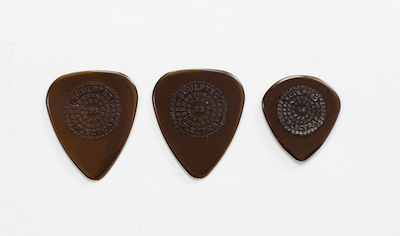
Dunlop Primetone picks are Ultex picks with a few extra features: textured grip, speed bevel, and hand-finish.
For standard mass-produced plastic picks, consider trying the Dunlop Primetone 351 (1mm)[?]Affiliate Link for a slightly higher-quality pick that is made with care and burnished by hand.
Must Try Picks
These picks made it to our “must try” list.
- Red Bear Picks — most famous
- US Blues Buffalo Horn Picks (Jazz)[?]Affiliate Link — similar to tortoise
- Carbon Fiber — world’s thinnest
- Chicken Pick — great bevel
Although not suitable for every player and every situation, they are attractive, well-made picks. you’ll need these to complete your pick collection.
Collectible Picks
If you’re a collector, you’ll want to have these.
- Surfpick — most natural
- Dunlop Teckpick[?]Affiliate Link — most reliable
- Stone Pick — most durable
- Abalone Pick — most beautiful
Top 3 Plectrums
Those interested in exploring the best picks currently available should try:
These picks stood out in for their quality, tone and feel. They all have great quality control and many options and styles.
 As the creator of Hub Guitar, Grey has compiled hundreds of guitar lessons, written several books, and filmed hundreds of video lessons. He teaches private lessons in his Boston studio, as well as via video chat through TakeLessons.
As the creator of Hub Guitar, Grey has compiled hundreds of guitar lessons, written several books, and filmed hundreds of video lessons. He teaches private lessons in his Boston studio, as well as via video chat through TakeLessons.